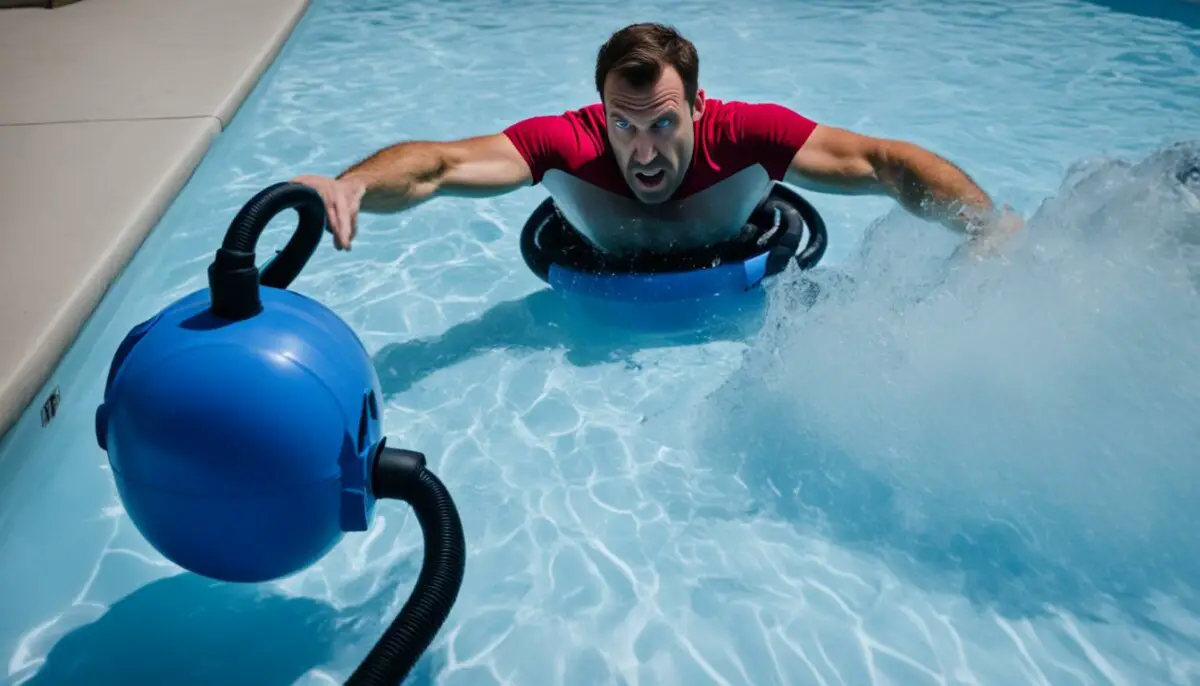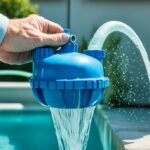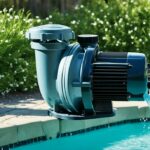Last Updated on 3 months by Francis
Are you frustrated with your pool vacuum constantly tipping over? Don’t worry, you’re not alone. Many pool owners face this common issue, but the good news is that there are solutions. In this article, we will explore troubleshooting tips to help you understand why your pool vacuum keeps going on its side and how to fix it.
Contents
Key Takeaways:
- Automatic pool cleaners play a crucial role in pool maintenance but can sometimes experience problems.
- There are three main types of automatic pool cleaners: suction side, pressure side, and robotic.
- For suction side cleaners, check for secure attachment, air leaks, and obstructions.
- Troubleshoot pressure side cleaners by inspecting the wheels, booster pump, and intake.
- Robotic cleaners may require checking power connections, tracks, and cleaning patterns.
Types of Automatic Pool Cleaners
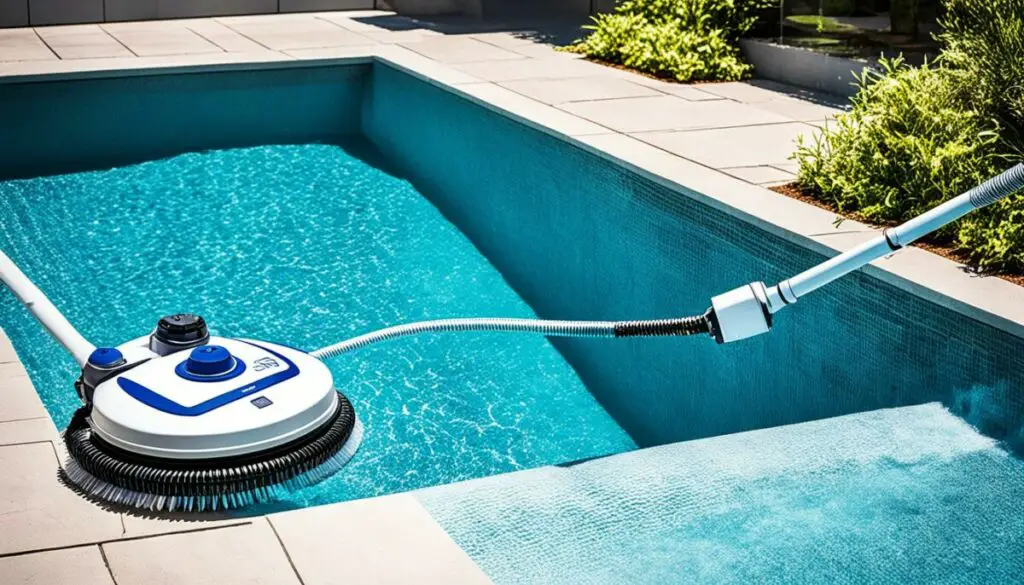
When it comes to maintaining your swimming pool, automatic pool cleaners are a game-changer. These innovative devices can save you time and effort by efficiently cleaning your pool without manual labor. There are three main types of automatic pool cleaners: suction side, pressure side, and robotic cleaners. Let’s take a closer look at each type:
Suction Side Cleaner
The suction side cleaner is a popular choice among pool owners. It connects to the pool’s suction line, utilizing the power of the pool pump to create suction and propel the cleaner around the pool. This type of cleaner is effective at removing small debris, such as leaves, dirt, and sand. Suction side cleaners are relatively affordable and easy to install and operate.
Pressure Side Cleaner
The pressure side cleaner operates on the pressure side of the filter pump. It uses the water pressure to move around the pool and collect debris. Pressure side cleaners often have their own dedicated booster pump to enhance their performance. They are capable of handling larger debris, such as twigs and acorns, and provide better circulation and water mixing in the pool.
Robotic Cleaner
A robotic cleaner is an independent cleaning machine that operates separately from the pool’s filtration system. It is powered by a standard power cord and has its own filtration system and cleaning mechanism. Robotic cleaners are highly efficient and offer advanced features like programmable cleaning cycles, remote control operation, and intelligent navigation. They can effectively clean all types of debris, including leaves, dirt, and algae.
Each type of automatic pool cleaner comes with its own advantages and features, catering to different pool sizes, debris types, and user preferences. Understanding the unique characteristics of each type can help you choose the most suitable cleaner for your pool.
Troubleshooting Suction Side Cleaners
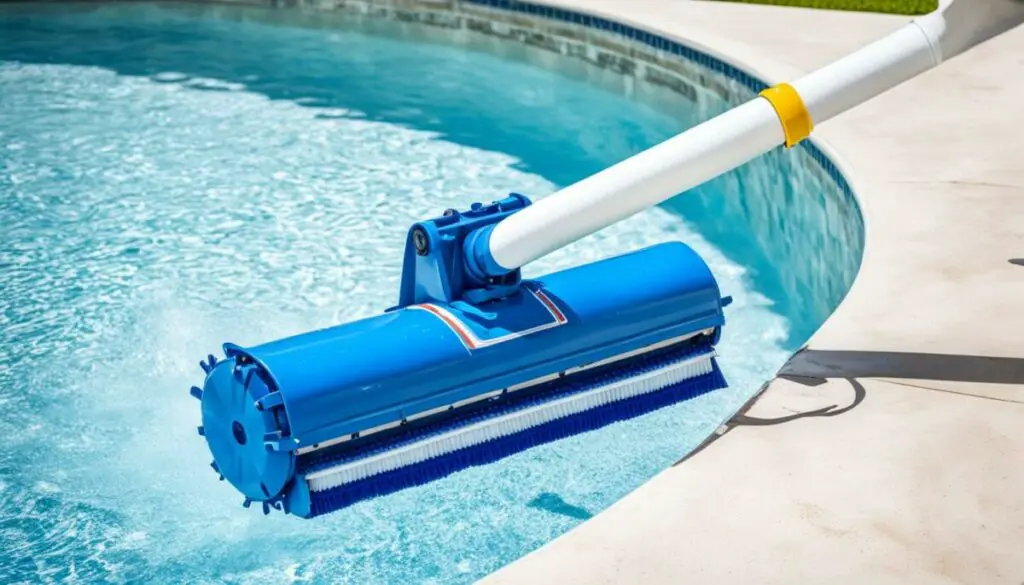
Suction side cleaners are popular choices for pool owners due to their simplicity and effectiveness. However, like any pool equipment, they can encounter issues that require troubleshooting. If you’re facing problems with your suction side cleaner, here are some common troubleshooting tips.
1. Suction Side Cleaner Does Not Move
If your suction side cleaner is not moving, there are a few potential causes to explore:
- Check the attachment: Ensure that the cleaner is securely attached to the pool’s suction line. If it is loose or not connected properly, it may not receive enough suction to move.
- Inspect the hose: Examine the cleaner’s hose for any air leaks or obstructions. Small cracks, holes, or debris can disrupt the suction and prevent the cleaner from moving.
2. Suction Side Cleaner Is Too Slow
A slow-moving suction side cleaner can be frustrating and may not effectively clean your pool. Consider these troubleshooting steps:
- Check the pool filter: A congested pool filter can restrict the flow of water and reduce the cleaner’s speed. Clean or backwash the filter to improve water flow.
- Inspect the intake hole: A clogged intake hole can also slow down the cleaner. Check for debris and remove any obstructions to optimize performance.
3. Suction Cleaner Does Not Cover Entire Pool
If your suction side cleaner is not reaching all areas of your pool, consider the following:
- Check the hose length: Make sure that the length of the cleaner’s hose is sufficient for your pool size. If it’s too short, it may limit the cleaner’s range.
- Inspect the return jets: Adjust the pool’s return jets to redirect the flow of water and ensure that the cleaner reaches all areas of your pool.
By troubleshooting these common issues, you can maximize the performance and efficiency of your suction side cleaner, ensuring a cleaner and healthier pool.
Troubleshooting Pressure Side Cleaners
Pressure side cleaners are powered by the pressure side of the filter pump. If your pressure side cleaner is not moving, there are a few troubleshooting steps you can take to identify and resolve the issue.
1. Check the booster pump
Make sure the booster pump, which provides additional pressure to the cleaner, is operating correctly. Check for any loose connections or clogged filters that may hinder its performance.
2. Inspect the wheels
Examine the cleaner’s wheels for any obstructions that may prevent them from rotating freely. Remove any debris or tangled debris that may be hindering their movement.
>
3. Clear inline strainers and intake
If your pressure side cleaner is slow-moving, there may be debris clogging the inline strainers or intake . Clean these areas thoroughly to ensure proper water flow and performance.
4. Adjust the thrust jet
If the pressure side cleaner does not cover the entire pool, adjusting the thrust jet can help redirect the cleaner and improve its coverage. Experiment with different positions to achieve optimal results.
5. Verify hose length
Ensure that the feed hose is long enough to reach all areas of your pool. If it is too short, the cleaner may not be able to cover the entire pool effectively. Consider using extension sections if necessary.
By troubleshooting these common issues, you can restore the functionality and efficiency of your pressure side cleaner, ensuring that it keeps your pool sparkling clean.
Troubleshooting Robotic Cleaners
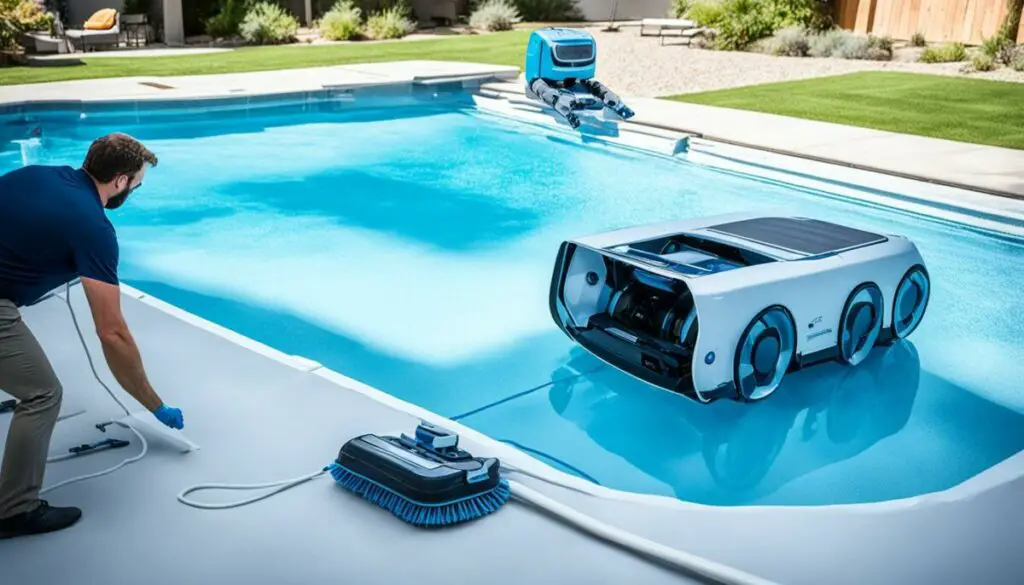
Robotic cleaners are a popular choice for pool owners due to their independence from the pool’s filter pump and efficient cleaning capabilities. However, like any other pool cleaner, robotic cleaners can experience issues that may hinder their performance. This section will provide troubleshooting tips for common problems encountered with robotic cleaners.
If your robotic cleaner is not moving, it is important to check the following:
- Power Connection: Ensure that the cleaner is properly connected to a power source. A loose or faulty connection can prevent the cleaner from moving correctly.
- Debris on Tracks or Wheels: Inspect the tracks or wheels of the cleaner for any debris or obstructions. Dirt, leaves, or small rocks can cause the cleaner to get stuck or move slowly.
If your robotic cleaner is moving slowly, the following factors may be contributing to the issue:
- Faulty Motor: A faulty motor can impact the speed and movement of the robotic cleaner. Consider contacting the manufacturer for troubleshooting or repair options.
- Worn Brushes: Over time, the brushes on the robotic cleaner may wear down, affecting its cleaning efficiency. Replace worn brushes to improve the cleaner’s performance.
For situations where the robotic cleaner gets stuck during its cleaning cycle, try the following solutions:
- Adjust the Cleaning Pattern: Some robotic cleaners offer adjustable cleaning patterns. Experiment with different patterns to find one that avoids obstacles and reduces the chances of the cleaner getting stuck.
- Use Additional Accessories: Consider adding accessories such as a floating buoy or a pool ladder deflector to prevent the cleaner from getting stuck on these objects.
By troubleshooting and addressing these common issues, you can restore your robotic cleaner’s functionality and ensure a clean and enjoyable swimming pool experience.
| Issue | Troubleshooting Steps |
|---|---|
| Robotic cleaner does not move | – Check the power connection – Inspect tracks or wheels for debris |
| Robotic cleaner is slow | – Check for a faulty motor – Replace worn brushes |
| Robotic cleaner gets stuck | – Adjust the cleaning pattern – Use additional accessories |
Common Troubleshooting Tips for All Pool Cleaners

When it comes to keeping your pool clean and sparkling, automatic pool cleaners are a lifesaver. However, like any mechanical device, they can sometimes encounter issues. Whether you have a suction side cleaner, a pressure side cleaner, or a robotic cleaner, there are some common troubleshooting tips that can help you solve the most common problems.
First and foremost, it’s essential to ensure that your pool’s operational equipment, including the pump, filter, and chlorinator, are all in good working condition. Poor equipment performance can directly impact the effectiveness of your pool cleaner.
If you’re experiencing suction problems, there are a few things you can check. Start by examining the flow control valve and adjusting it if necessary. This valve controls the amount of suction that reaches the cleaner. Additionally, inspect the cleaner hose for any air leaks or tangles that may be affecting its performance.
Speed issues are another common problem pool owners face. If your cleaner is moving too slowly, it could be due to a clogged filter or a restriction in the water flow. Clean or replace the filter as needed, and ensure that the water circulation in your pool is functioning optimally.
The cleaner hose can also be prone to tangles, which can impede the cleaner’s movement. Regularly inspect the hose to ensure it is free from any knots or obstructions. If you notice any tangles, carefully untangle them to restore the cleaner’s full range of motion.
Remember, regardless of the type of pool cleaner you have, regular maintenance and troubleshooting are key to ensuring its optimal performance. By following these common troubleshooting tips, you can keep your pool cleaner running smoothly and enjoy a beautifully clean pool year-round.
By applying these troubleshooting tips, you’ll be able to address common issues with your pool cleaners, such as suction problems, speed issues, and hose tangles. Keeping your pool cleaner in good working condition will help you maintain a clean and inviting swimming pool for all to enjoy.
Maintaining Your Pool Cleaner
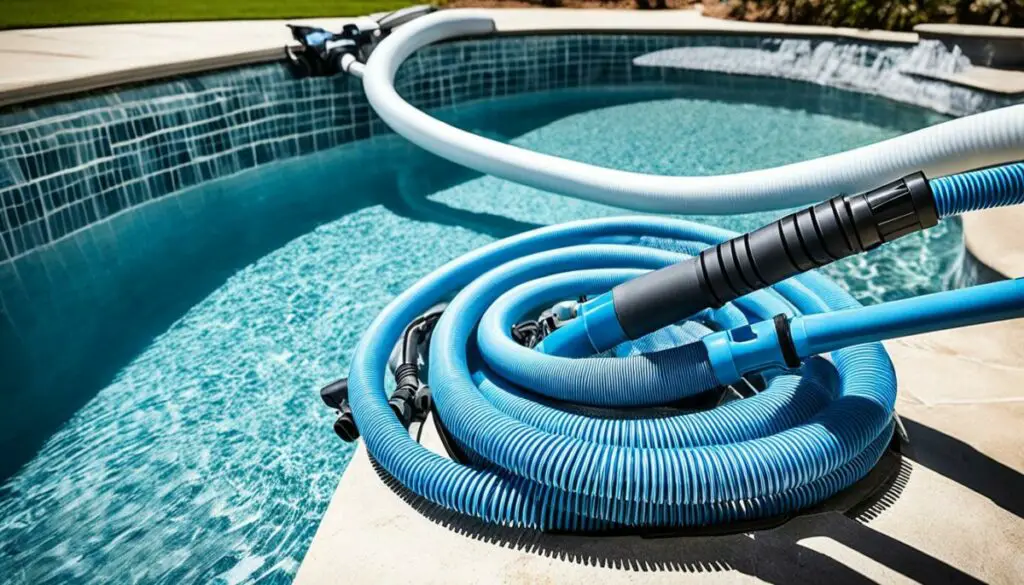
Proper maintenance is crucial for the longevity and performance of your pool cleaner. By taking the time to regularly clean and inspect the cleaner’s parts, you can ensure that it continues to operate effectively. Here are some essential maintenance tips:
1. Clean and Inspect the Cleaner’s Parts
Regular cleaning and inspection of the diaphragm, wheels, brushes, and filters are essential to keep your pool cleaner in optimal condition. Remove any debris or dirt that may have accumulated to prevent clogs or damage.
2. Replace Worn or Damaged Parts
If you notice any worn or damaged parts during your inspection, such as a cracked diaphragm or worn-out brushes, it is crucial to replace them promptly. Using pool cleaner part replacements from reputable brands will help maintain the cleaner’s efficiency and performance.
3. Clean the Skimmer and Pump Baskets
Ensuring that the skimmer and pump baskets are free from debris is essential for the proper functioning of your pool cleaner. Regularly clean these baskets to prevent blockages and improve overall pool circulation.
4. Maintain the Proper Water Level
An adequate water level is necessary for your pool cleaner to function effectively. Check and maintain the water level within the manufacturer’s recommended range to avoid any issues or inefficiencies.
| Pool Cleaner Maintenance Checklist |
|---|
| Clean and inspect diaphragm, wheels, brushes, and filters |
| Replace worn or damaged parts with quality replacements |
| Clean skimmer and pump baskets regularly |
| Maintain the proper water level in the pool |
By following these maintenance tips, you can ensure that your pool cleaner operates at its best, providing you with a clean and inviting swimming pool.
Preventive Measures for Pool Cleaner Issues
To prevent common pool cleaner issues and ensure its optimal performance, it is essential to implement preventive measures and regular maintenance. By following these simple care tips, you can extend the life of your pool cleaner and minimize the need for troubleshooting.
Regular Cleaning and Maintenance
Regularly clean your pool and its equipment to prevent debris buildup, which can clog the cleaner and hinder its efficiency. Here are some maintenance tasks to include in your routine:
- Clean the pool’s skimmers and pump baskets to prevent debris from entering the cleaner.
- Remove leaves, twigs, and any other large debris from the pool before operating the cleaner.
- Inspect and clean the cleaner’s filters, wheels, brushes, and other components according to the manufacturer’s instructions.
- Check and clean the cleaner’s intake ports for any obstructions or blockages.
- Regularly check and maintain the pool’s water chemistry to prevent algae growth and other water-related issues.
Avoid Operating in Excessive Debris
Avoid running the pool cleaner when there is excessive debris in the pool. Large amounts of leaves, dirt, or other debris can overload the cleaner and cause it to clog or malfunction. Instead, manually clean the pool or use a leaf skimmer to remove the debris before using the cleaner.
Consider a Leaf Canister or Robotic Cleaner
If your pool is prone to high leaf or debris circulation, consider using a leaf canister attachment or opting for a robotic cleaner. A leaf canister acts as an additional filter and collects large debris before it reaches the cleaner, preventing blockages and extending its lifespan. Robotic cleaners are equipped with powerful built-in filters and are capable of efficiently capturing and removing debris, making them an excellent choice for pools with heavy leaf or debris loads.
Proper Storage and Handling
When not in use, properly store and handle your pool cleaner to avoid coil memory or damage to its components. Here are some tips for storing and handling your cleaner:
- Store the cleaner in a dry and secure location, away from direct sunlight or extreme temperatures.
- Avoid coiling the cleaner’s hose tightly as it can cause coil memory and reduce its flexibility. Instead, loosely coil the hose or use a hose hanger for proper storage.
- Handle the cleaner with care to avoid unnecessary bumps or impacts that could damage its delicate components.
By implementing these preventive measures and providing regular care for your pool cleaner, you can enjoy a clean and well-maintained swimming pool all year round.
Hiring a Professional Pool Technician
If you have exhausted all troubleshooting steps and your pool cleaner is still not functioning properly, it may be time to seek professional assistance. Pool technicians specialize in pool cleaner repair, maintenance, and troubleshooting, offering expert services to ensure the optimal performance of your pool cleaner.
When you hire a pool technician, you can expect the following services:
- Thorough Troubleshooting: A pool technician will conduct a comprehensive assessment of your pool cleaner, diagnosing any underlying issues that may be causing the malfunction.
- Professional Repair: If your pool cleaner requires repair, the technician will have the expertise and tools to efficiently fix the problem. Whether it’s a motor issue, a faulty component, or a mechanical malfunction, they will work diligently to restore your pool cleaner to optimal condition.
- Maintenance and Cleaning: Pool technicians can also provide routine maintenance and cleaning services to keep your pool cleaner running smoothly. They will inspect and clean essential parts, such as filters, brushes, and wheels, ensuring optimal performance and longevity for your pool cleaner.
By hiring a professional pool technician, you can save time and avoid the frustration of dealing with persistent pool cleaner issues. They have the knowledge and experience to quickly identify and resolve problems, providing you with peace of mind and a well-maintained pool cleaner.
An image related to pool cleaner troubleshooting professional assistance will be added here:
When it comes to your pool cleaner’s performance, don’t hesitate to reach out to a pool technician for professional assistance. They will ensure that your pool cleaner is repaired, maintained, and functioning efficiently, so you can enjoy crystal clear and refreshing pool water all season long.
Conclusion
In conclusion, troubleshooting pool cleaner issues is essential for maintaining a clean and enjoyable swimming pool experience. By identifying the specific type of cleaner and addressing the common problems associated with it, you can effectively resolve any issues that may arise. Regular maintenance, including cleaning and inspecting the cleaner’s parts, and implementing preventive measures, such as maintaining a debris-free pool and proper storage, can significantly contribute to the longevity and performance of your pool cleaner.
Remember to follow the troubleshooting tips specific to your type of pool cleaner, whether it’s a suction side, pressure side, or robotic cleaner to ensure optimal functionality. Additionally, seeking professional assistance from a pool technician can provide further troubleshooting, repairs, or maintenance services when needed.
By implementing these troubleshooting pool cleaner tips and staying proactive in your pool cleaner maintenance, you can enjoy a sparkling clean pool all season long. Keep your pool cleaner running smoothly, maintain a clean and enjoyable swimming environment, and make the most of your pool experience.
FAQ
Why does my pool vacuum keep going on its side?
There could be several reasons why your pool vacuum keeps going on its side. It could be due to a misaligned hose, a clogged intake hole, or an unbalanced water flow. Troubleshooting and properly maintaining your pool cleaner can help resolve this issue.
How can I troubleshoot my pool vacuum?
To troubleshoot your pool vacuum, start by checking the attachment to the suction line or the wheels for any obstructions. Inspect the hose for air leaks or tangles, and ensure that the pool’s operational equipment, such as the pump and filter, are in good working condition.
What are the different types of automatic pool cleaners?
The three main types of automatic pool cleaners are suction side cleaners, pressure side cleaners, and robotic cleaners. Suction side cleaners connect to the pool’s suction line, pressure side cleaners operate on the pressure side of the filter pump, and robotic cleaners are independent and powered by a standard power cord.
How can I troubleshoot a suction side cleaner?
If your suction side cleaner is not moving or tilting, check for a secure attachment to the suction line and inspect the hose for air leaks or obstructions. A slow-moving cleaner might be due to a congested pool filter or a clogged intake hole. Ensure the cleaner’s hose length is sufficient and check the pool’s return jets for any adjustments.
How can I troubleshoot a pressure side cleaner?
If your pressure side cleaner is not moving properly, check that the booster pump is operating and inspect the wheels for any obstructions. A slow-moving cleaner might be due to debris in the inline strainers or a clogged intake. Adjust the thrust jet and verify that the feed hose is long enough to ensure proper coverage.
How can I troubleshoot a robotic cleaner?
If your robotic cleaner is not moving or keeps getting stuck, check that it is properly connected to a power source and inspect the tracks or wheels for any debris. A slow-moving cleaner might be due to a faulty motor or worn brushes. Consider adjusting the cleaning pattern or adding additional accessories to prevent obstruction.
What are some common troubleshooting tips for all pool cleaners?
Some common troubleshooting tips for all pool cleaners include checking for suction problems, adjusting the flow control valve if needed, and inspecting the cleaner hose for any air leaks or tangles. Regular maintenance of the pool’s operational equipment and ensuring proper water levels are also crucial.
How should I maintain my pool cleaner?
To maintain your pool cleaner, regularly clean and inspect the cleaner’s parts such as the diaphragm, wheels, brushes, and filters. Replace any worn or damaged parts as needed. Additionally, clean the skimmer and pump baskets, and ensure the pool’s water level is adequate for the cleaner to function properly.
What preventive measures can I take to prevent pool cleaner issues?
To prevent pool cleaner issues, regularly clean and maintain your pool and its equipment to prevent debris buildup. Avoid running the cleaner when there is excessive debris in the pool. Use a leaf canister or consider a robotic cleaner for pools with high leaf or debris circulation. Properly store and handle the cleaner when not in use to avoid coil memory or damage.
When should I hire a professional pool technician?
If you have tried troubleshooting steps and your pool cleaner is still not functioning properly, it may be time to seek professional assistance. A pool technician can provide further troubleshooting, repairs, or maintenance services to ensure your pool cleaner is working efficiently.

